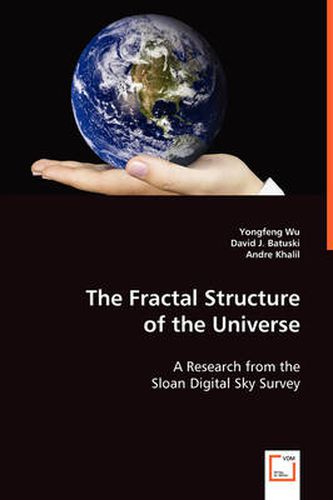Readings Newsletter
Become a Readings Member to make your shopping experience even easier.
Sign in or sign up for free!
You’re not far away from qualifying for FREE standard shipping within Australia
You’ve qualified for FREE standard shipping within Australia
The cart is loading…






This title is printed to order. This book may have been self-published. If so, we cannot guarantee the quality of the content. In the main most books will have gone through the editing process however some may not. We therefore suggest that you be aware of this before ordering this book. If in doubt check either the author or publisher’s details as we are unable to accept any returns unless they are faulty. Please contact us if you have any questions.
The fractal dimension of the spatial distribution of galaxies can be characterized by various statistical and topological methods, such as the Two-point Correlation Function, Perimeter-Area, Box Counting, and the Gamma Function. Here we develop a new way to get fractal information, that is the Metric Space Technique (MST). It allows multi-ple measures to be simultaneously applied for quantitative analysis of any type of structure distribution. All such distributions are considered to be elements of multi-parameter space, and the analysis is based on considering output functions, which characterize the distributions in multi-parameter space. We also develop both the Box Counting and Perimeter-Area method with the Hexagon Cell technique to calculate the fractal dimension of our samples. We compare results from Sloan Digital Sky Survey Data Release 5 with that of mock samples of ga-laxies from N-body simulation, nested-pairs simulations and random catalogs. By systematically studying hundreds of thousands of ga-laxies, we demonstrate that in the local universe there exists a fractal structure from MST. We also discuss the possible improvement for mock samples.
$9.00 standard shipping within Australia
FREE standard shipping within Australia for orders over $100.00
Express & International shipping calculated at checkout
This title is printed to order. This book may have been self-published. If so, we cannot guarantee the quality of the content. In the main most books will have gone through the editing process however some may not. We therefore suggest that you be aware of this before ordering this book. If in doubt check either the author or publisher’s details as we are unable to accept any returns unless they are faulty. Please contact us if you have any questions.
The fractal dimension of the spatial distribution of galaxies can be characterized by various statistical and topological methods, such as the Two-point Correlation Function, Perimeter-Area, Box Counting, and the Gamma Function. Here we develop a new way to get fractal information, that is the Metric Space Technique (MST). It allows multi-ple measures to be simultaneously applied for quantitative analysis of any type of structure distribution. All such distributions are considered to be elements of multi-parameter space, and the analysis is based on considering output functions, which characterize the distributions in multi-parameter space. We also develop both the Box Counting and Perimeter-Area method with the Hexagon Cell technique to calculate the fractal dimension of our samples. We compare results from Sloan Digital Sky Survey Data Release 5 with that of mock samples of ga-laxies from N-body simulation, nested-pairs simulations and random catalogs. By systematically studying hundreds of thousands of ga-laxies, we demonstrate that in the local universe there exists a fractal structure from MST. We also discuss the possible improvement for mock samples.